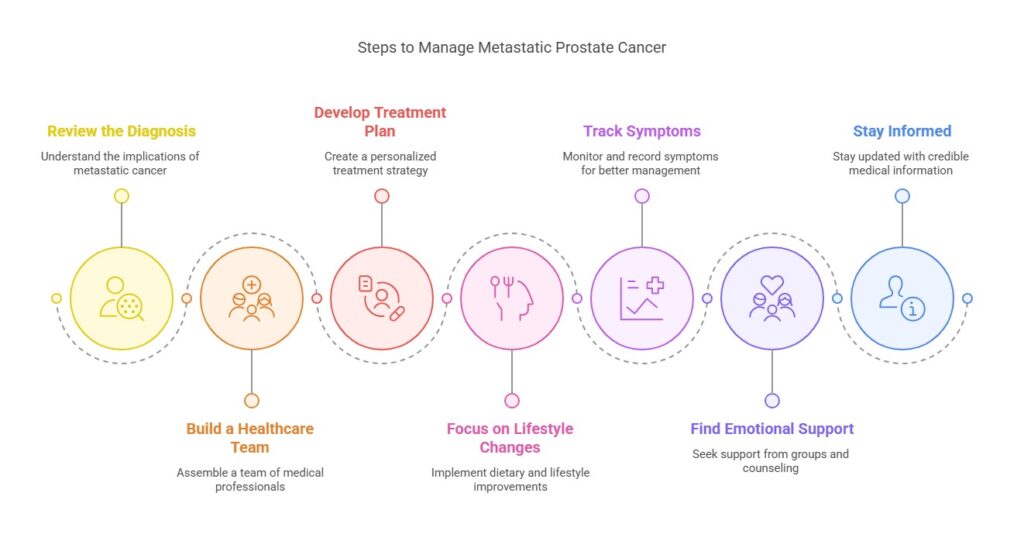
Table of Contents
Introduction
A diagnosis of metastatic prostate cancer can feel like a seismic shift, leaving you grappling with uncertainty and fear. But here’s the truth: you have more power than you realize. This isn’t just about managing a disease—it’s about reclaiming your life. Imagine transforming overwhelm into actionable steps, fear into empowerment, and uncertainty into clarity. From understanding your diagnosis to building a robust support system, this guide unveils seven pivotal strategies to help you confidently navigate this journey. Ready to take the reins? Let’s explore how you can take control of your health and thrive, even in the face of metastatic prostate cancer.

Step 1: Review the Diagnosis
When you hear the term “metastatic”, it may be cytokine storm–like your mind is flooded with uncertainty. If you are told someone has metastatic prostate cancer, it simply means that cancer has travelled outside of the prostate — which is where it originated — into other areas of the body (such as bones, lymph nodes, or organs). Recognizing that is the first step toward regaining control of your health.
Get acquainted with important terms, such as PSA levels (a marker for prostate cancer activity), Gleason score (which measures the aggressiveness of cancer) and staging (how far cancer has progressed). These specifics aren’t mere medical jargon — they are tools to help you and your healthcare team create a personalized plan. Knowledge is power, and knowing your diagnosis prepares you to make informed decisions regarding your care.
Step 2 — Your Healthcare Dream Team
Dealing with metastatic prostate cancer isn’t exactly a road you want to walk all alone. Building a team of skilled healthcare professionals is essential. Begin with specialists such as oncologists and urologists, but don’t forget the role of palliative care experts, who can help manage symptoms and improve your quality of life.
When selecting your team, consider questions like: What is your experience with metastatic prostate cancer? What’s your philosophy on personalized care? A patient advocate or caregiver can also be invaluable and act as your voice during appointments. Keep in mind that this is your team—select professionals who are a good fit for your needs, who you trust, and who align with your values.
Step 3: Develop an Individualized Treatment Plan
There is no one-size-fits-all treatment for metastatic prostate cancer. Choices include hormone therapy and chemotherapy, as well as immunotherapy and radiation. Each has unique benefits and risks, so talking with your doctor is critically important.
Talk about how each treatment matches your goals—extending life, treating symptoms, or both. Don’t rule out clinical trials, which may provide access to advanced therapies. A personalized treatment plan isn’t simply about battling cancer; it’s about making sure your care matches your individual needs and priorities.
Step 4: Focus on Lifestyle Changes
Medical treatments are crucial, but lifestyle changes can help support your overall wellness. The first step is your diet: add anti-inflammatory food like leafy greens, berries, and fatty fish, which can help mitigate inflammation and enhance immunity.
The same goes for exercise, even for gentle walks or stretching. Regular activity can boost your energy, combat stress and fortify your body. And don’t neglect mental health — things like mindfulness and meditation or therapy can help you deal with the emotional cost of a cancer diagnosis.” Low-key changes, consistently made, can create a big difference in how you feel.
Step 5: Track Symptoms & Stay Ahead of Side Effects
The reality of living with metastatic prostate cancer is often one of the symptoms, whether that means controlling bone pain, fatigue or urinary problems. Tracking these symptoms in detail could aid your doctor in periodically refining your treatment plan—track symptoms with tools like symptom-tracking apps, journals or regular check-ins with a caregiver.
It’s just as critical to know when to seek help. If you have significant pain, unexplained weight loss, or any other worrisome changes, you should never hesitate to call your healthcare team. Being proactive about symptom treatment can avoid complications and improve your quality of life.
Step 6: Find Emotional & Mental Support
A cancer diagnosis can impact your mental health, but it doesn’t have to be done alone. Online or in-person support groups can create a sense of community and understanding. Counselling, too, can be a lifeline, supporting you and your family through the emotional aspects of this journey.
You can also build resiliency by participating in hobbies and maintaining social ties. Whether gardening, painting or just being with friends or family, there could be moments of joy and routine in an otherwise uncertain life.
Step 7: Empower Yourself & Stay Informed
In the information age, we are inundated with conflicting advice. Limit yourself to credible sources, such as medical journals, reputable cancer organizations, and your health care team. Come with questions before appointments, and don’t be afraid to ask for clarification if something is unclear.
Second opinions can also be precious, as they can bring new patient perspectives to your treatment options. After all, you’re not only a patient but a participant in your care. Advocating for yourself helps ensure you are heard and meet your needs.

A shocking medical study reveals how a mysterious “Brazilian Jelly” is giving men overnight relief from prostate issues—restoring vitality and freedom without meds or surgery. Check out for more!
Conclusion
Summing Up the Pros and Cons: Is It Worth Trying?
A diagnosis of metastatic prostate cancer may seem like a tectonic shift, but it needn’t define your life. By proactively following these seven foundational steps, you can take back control and confidently move forward in your journey. You’re not a patient; you’re the C.E.O. of your health. Take one step today and share this guide with someone who may need it. Be brave and hold onto hope. We will get through this as one.
For those seeking additional resources and support in managing metastatic prostate cancer, consider exploring this comprehensive guide to discover tools and strategies that can empower your journey.





